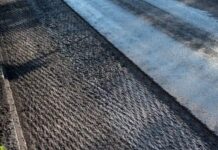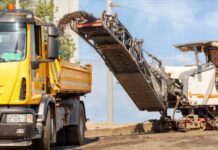Potholes—those ugly, inconvenient depressions in asphalt—are more than just eyesores. They are safety hazards, vehicle-damaging nuisances, and liabilities for property owners. Whether you’re managing a residential driveway or a large commercial parking lot, timely pothole repair is critical for maintaining curb appeal, safety, and structural integrity.
At Commonwealth Paving, located at 136 Outerloop, Louisville, Kentucky 40214, we specialize in fast, durable, and affordable pothole repair solutions. But before choosing a repair method, it’s essential to understand the different techniques available—and which ones are best suited for your specific needs.
This blog post explores the most common pothole repair techniques, weighing the pros and cons of each to help you make an informed decision. So whether you’re a property manager, business owner, or homeowner, consider this your complete guide to smarter pavement restoration.
What Causes Potholes?
Before diving into repair options, it helps to understand what causes potholes in the first place.
Potholes typically form due to:
- Water infiltration through surface cracks
- Freezing and thawing cycles
- Repeated vehicle pressure
- Subsurface erosion
Over time, the surface weakens, collapses, and breaks apart—leaving dangerous holes that worsen if ignored.
That’s where professional pothole repair comes in—and knowing your options matters.
1. Cold Patch Asphalt Repair
Cold patching is one of the most widely used pothole repair techniques, particularly in colder climates or during emergency situations.
How It Works:
A pre-mixed asphalt compound is poured directly into the pothole, tamped down with hand tools or compactors, and left to cure.
Pros:
- Quick and easy application
- No special equipment required
- Works in any weather, even winter
- Cost-effective short-term solution
Cons:
- Not a permanent fix
- Can loosen over time under heavy traffic
- More prone to water infiltration
Best For: Temporary or emergency repairs when weather conditions prevent hot asphalt application.

At Commonwealth Paving, we use cold patching when fast action is needed, especially during winter months in Louisville. For long-term solutions, we recommend more durable methods.
2. Hot Mix Asphalt Repair
Hot mix asphalt is the gold standard in pothole repair. This method involves using hot asphalt to fill the pothole after cleaning and preparing the area.
How It Works:
The damaged asphalt is cut and removed, the area is cleaned, then filled with hot mix asphalt which is compacted for a smooth, strong finish.
Pros:
- Durable and long-lasting
- Seamlessly blends with existing pavement
- Resistant to weather and traffic damage
- Professional-grade results
Cons:
- Requires specialized equipment
- Needs warm, dry weather to apply
- Higher upfront cost than cold patching
Best For: Permanent repairs on driveways, streets, and commercial lots.
At Commonwealth Paving, we highly recommend hot mix pothole repair for clients looking for a dependable, long-term solution that withstands Louisville’s traffic and seasons.
3. Throw-and-Roll Repair
This method is a hybrid between cold patching and compaction. It’s a fast solution used by many during colder seasons or in high-traffic areas where downtime is limited.
How It Works:
Cold mix is thrown into the pothole, and then compacted by rolling over it with a vehicle or roller.
Pros:
- Fast deployment
- Can be done in high-traffic areas
- Requires minimal equipment
Cons:
- Not long-lasting
- Can become loose or rutted under traffic
- Often needs re-application
Best For: Temporary repairs in busy lots or roads with high vehicle volume.
At Commonwealth Paving, we might use this technique during emergency projects or when traffic management is limited—but always with a plan to return for permanent repair.
4. Infrared Asphalt Repair
One of the more modern pothole repair techniques, infrared repair uses infrared technology to heat the existing asphalt, blend it with new material, and recompact it.
How It Works:
An infrared machine heats the damaged area to soften the asphalt, which is then rejuvenated, mixed with new asphalt if needed, leveled, and compacted.
Pros:
- Seamless, watertight finish
- Eco-friendly (reuses existing material)
- No cutting or sawing required
- Cost-effective long-term
Cons:
- Equipment is expensive and specialized
- Not suitable for severely damaged areas
- Requires trained technicians
Best For: Driveways or parking lots where aesthetics and surface integrity are important.
Commonwealth Paving offers infrared pothole repair for clients who want eco-conscious solutions without compromising on quality and performance.
5. Full-Depth Patching
This is the most intensive and durable pothole repair method, typically used when the damage extends beneath the asphalt into the base layer.

How It Works:
The entire damaged section—surface and base—is excavated, replaced, and compacted with new materials.
Pros:
- Permanent and highly durable
- Fixes both surface and structural issues
- Prevents future potholes in the same spot
Cons:
- Time-consuming
- More expensive than surface patching
- Requires experienced professionals
Best For: Severe pothole damage or when base layers have failed.
At Commonwealth Paving, we recommend full-depth patching for commercial lots or heavily trafficked areas in Louisville that require robust structural repairs.
6. Spray Injection Patching
Spray injection is a specialized method where a high-pressure spray nozzle is used to blow out debris and moisture from the pothole and then injects asphalt and aggregate in layers.
How It Works:
Compressed air is used to clean the pothole, followed by spraying a tack coat and aggregate-filled emulsion.
Pros:
- Fast and efficient
- Requires no compaction
- Less traffic disruption
Cons:
- Requires special machinery
- Not ideal for large or deep potholes
- Best in dry conditions
Best For: Moderate pavement damage in commercial parking lots or city roads.
Commonwealth Paving offers spray injection repair for projects where speed and reduced downtime are a priority.
Comparison Table of Pothole Repair Methods
| Method | Durability | Cost | Weather Limitations | Equipment Needed | Best Use Case |
|---|---|---|---|---|---|
| Cold Patch | Low | Low | None | Minimal | Temporary winter repairs |
| Hot Mix Asphalt | High | Medium-High | Yes (Warm, Dry) | Advanced | Permanent, high-traffic areas |
| Throw-and-Roll | Medium | Low | None | Minimal | Fast, temporary fix |
| Infrared Asphalt | High | Medium | Limited | Specialized | Seamless, eco-friendly repair |
| Full-Depth Patching | Very High | High | Yes | Heavy equipment | Structural, long-term solution |
| Spray Injection | Medium | Medium | Yes (Dry) | Specialized | Quick fix with minimal traffic disruption |
Choosing the Right Pothole Repair Technique
The ideal pothole repair method depends on several factors:
- Size and depth of the pothole
- Weather conditions
- Budget
- Traffic volume
- Timeline for repair
At Commonwealth Paving, we offer a free on-site assessment to evaluate your situation and recommend the best repair option based on long-term value, budget, and durability.
Why Choose Commonwealth Paving for Pothole Repair?
Located at 136 Outerloop, Louisville, Kentucky 40214, Commonwealth Paving has earned the trust of residents and business owners for high-quality, affordable, and long-lasting pothole repair solutions.
Our Advantages:
✅ Over 20 years of paving experience
✅ Licensed, bonded, and insured
✅ State-of-the-art equipment and techniques
✅ Free estimates and inspections
✅ Local experts who understand Kentucky’s unique weather and road conditions
We handle everything from small driveway repairs to large commercial pothole patching projects with professionalism and precision.
📞 Call us today at +1 502 459 7283 for expert service you can count on.
Final Thoughts: Invest in Quality Pothole Repair That Lasts
Potholes don’t fix themselves—and if ignored, they grow larger, more dangerous, and more expensive. Understanding the different pothole repair techniques can save you time, money, and stress.
Whether you need a temporary fix in the dead of winter or a long-lasting solution that protects your property year-round, Commonwealth Paving is ready to deliver top-notch results.
Contact us now at +1 502 459 7283 or visit our office at 136 Outerloop, Louisville, Kentucky 40214 to schedule your free estimate. Your pavement deserves the best—let us provide it.
How Weather Conditions Affect Pothole Repair: Best Practices for Every Season
Potholes are the unwanted guests on our roads, driveways, and parking lots. They appear suddenly, grow quickly, and wreak havoc on vehicles and pavement alike. But did you know that weather conditions play a major role in how potholes form—and how successful a pothole repair will be?
Whether you’re facing freezing winter temperatures or the scorching summer sun in Kentucky, understanding the relationship between weather and pothole repair is essential to maintaining long-lasting, safe, and cost-effective asphalt surfaces.
At Commonwealth Paving, located at 136 Outerloop, Louisville, Kentucky 40214, we specialize in pothole repair solutions tailored to every season. With years of experience serving residential, commercial, and municipal clients, we know exactly how to navigate the weather challenges that Kentucky brings year-round.
In this blog, we break down how different weather conditions affect pothole repair, and share the best practices for each season—so your pavement stays smooth, safe, and strong no matter the climate.
Why Weather Matters in Pothole Repair
Potholes are caused by a combination of moisture, temperature shifts, and repetitive traffic stress. Water seeps into cracks, freezes, expands, and weakens the asphalt. When that frozen water melts, it leaves voids behind. Combine that with the pressure of passing vehicles, and suddenly, your pavement caves in—leaving a pothole.
But it doesn’t stop there. Repairing potholes during the wrong weather conditions can lead to short-term fixes, failed patches, and costly rework. That’s why every season requires a different repair approach.
Winter: Emergency Repairs in Harsh Conditions
Weather Challenges:
- Freezing temperatures
- Snow and ice buildup
- Constant freeze-thaw cycles
- Moisture infiltration
How It Affects Pothole Repair:
In winter, the pavement is cold, often wet or icy, and asphalt plants may be closed. These conditions make it extremely difficult to perform long-lasting pothole repairs. However, ignoring potholes in winter is not an option—especially for busy driveways, streets, or parking lots.
Best Practice: Cold Patch Repairs
At Commonwealth Paving, we use cold mix asphalt for emergency pothole repair during the winter months. This method allows for quick, temporary fixes that prevent further damage until spring.
Pros of Cold Patch in Winter:
- Can be applied in freezing temperatures
- Fast and convenient
- Prevents potholes from growing worse
Cons:
- Not a permanent fix
- May loosen over time
📍 Winter Tip from Commonwealth Paving: If you notice a pothole forming, don’t wait! Call +1 502 459 7283 for a fast cold patch solution that protects your pavement until warmer weather arrives.
Spring: Ideal Time for Long-Lasting Repairs
Weather Challenges:
- High moisture from rain
- Soft or thawed ground
- Early thaw and temperature shifts
How It Affects Pothole Repair:
Spring is often the best season to evaluate and repair pothole damage caused by winter. As temperatures rise and asphalt plants reopen, contractors can use hot mix asphalt, which provides a durable, permanent repair.
However, spring showers can delay repairs, especially if the pavement is waterlogged.
Best Practice: Hot Mix Asphalt with Proper Drainage
Commonwealth Paving recommends hot mix pothole repair in spring, with special attention to water drainage and base compaction to ensure the patch holds for years.
Pros of Spring Repairs:
- More stable weather conditions
- Asphalt plants are open
- Ideal temperatures for curing
- Excellent bonding and compaction
Cons:
- Wet conditions may delay scheduling
- Soft subgrade may need extra attention
📍 Spring Tip from Commonwealth Paving: After winter, schedule a complete asphalt inspection to identify hidden potholes and cracks early. Call us at +1 502 459 7283 to book your spring evaluation.

Summer: Peak Season for Pothole Repair
Weather Challenges:
- High temperatures
- Occasional heavy storms
- Pavement expansion from heat
How It Affects Pothole Repair:
Summer is considered the prime time for pothole repair. With dry, warm conditions and full access to hot mix asphalt, this season allows for the most effective and durable repairs.
However, extreme heat can cause asphalt to become soft or oily, which may affect the performance of the patch if not properly managed.
Best Practice: Hot Mix Asphalt + Infrared Repairs
At Commonwealth Paving, summer is when we perform full-depth repairs and infrared pothole repair. This method uses heat to blend new asphalt seamlessly into existing pavement for a smooth, long-lasting finish.
Pros of Summer Repairs:
- Ideal curing temperature
- Long-lasting adhesion
- Faster work time due to warm weather
- Allows for full-depth and large area repairs
Cons:
- Extreme heat can soften asphalt too much
- Storms may interrupt schedules
📍 Summer Tip from Commonwealth Paving: Take advantage of the weather to schedule preventative repairs. Don’t just fix potholes—seal cracks and recoat your driveway too!
Fall: The Last Call for Permanent Repairs
Weather Challenges:
- Falling temperatures
- Increased rain
- Approaching frost
How It Affects Pothole Repair:
Fall is the last chance before winter to make permanent pothole repairs. Asphalt plants remain open, but cooler evenings can affect curing times and patch bonding. That means timing and technique are critical.
Best Practice: Hot Mix Asphalt with Surface Sealing
Fall is a great time to not only repair potholes but also apply sealcoating to protect the entire surface from upcoming winter damage.
Pros of Fall Repairs:
- Still warm enough for hot mix
- Protects pavement before freeze-thaw cycle returns
- Ideal time for inspections
Cons:
- Limited time window
- Shorter days reduce working hours
📍 Fall Tip from Commonwealth Paving: Repair and seal in the fall to reduce the risk of costly pothole formation during winter. Book your fall maintenance service today by calling +1 502 459 7283.
Year-Round Best Practices for Pothole Repair
No matter the season, there are universal rules for effective pothole repair. At Commonwealth Paving, we follow these best practices year-round:
1. Inspect Frequently
Perform regular inspections to catch potholes early, before they become major hazards.
2. Clean the Area Thoroughly
Remove all debris, loose material, and moisture before applying any patch.
3. Compact Properly
Whether using hot or cold mix, proper compaction ensures durability.
4. Use the Right Material for the Season
Don’t use hot mix in freezing weather or cold patch in summer unless necessary.
5. Monitor Repairs
Even the best repairs can degrade over time. Re-inspect patched areas seasonally.
Why Choose Commonwealth Paving for Year-Round Pothole Repair?
When weather throws challenges at your pavement, you need a local expert who knows how to handle Kentucky’s unpredictable climate. That’s where Commonwealth Paving comes in.
📍 Located at 136 Outerloop, Louisville, Kentucky 40214, our team of seasoned professionals delivers custom pothole repair solutions designed for every season.
What Sets Us Apart:
✅ Weather-appropriate repair methods
✅ Professional-grade equipment
✅ 20+ years of local experience
✅ Emergency service available
✅ Honest, transparent pricing
✅ Family-owned and community-trusted
📞 Call us today at +1 502 459 7283 to schedule your inspection or pothole repair. Our mission is to keep your driveway, road, or lot safe and flawless year-round.
Final Thoughts: Beat the Weather, Beat the Potholes
No two seasons are the same—and no pothole should be treated the same way year-round. Whether it’s the icy grip of winter or the humid heat of summer, understanding how weather affects pothole repair helps you plan smarter and avoid costly damage.
At Commonwealth Paving, we don’t just patch holes—we provide tailored solutions that keep your pavement protected no matter the forecast.
Don’t wait for the next storm or freeze. Call +1 502 459 7283 today and let us show you why we’re Louisville’s trusted pothole repair experts.
Address
Commonwealth Paving, 136 Outerloop, Louisville, Kentucky 40214
Phone: 502-459-7283, Fax: 502-456-2678
Opening Hours
| Monday | 9:00 AM – 5:00 PM |
| Tuesday | 9:00 AM – 5:00 PM |
| Wednesday | 9:00 AM – 5:00 PM |
| Thursday | 9:00 AM – 5:00 PM |
| Friday | 9:00 AM – 5:00 PM |
| Saturday | Closed |
| Sunday | Closed |






